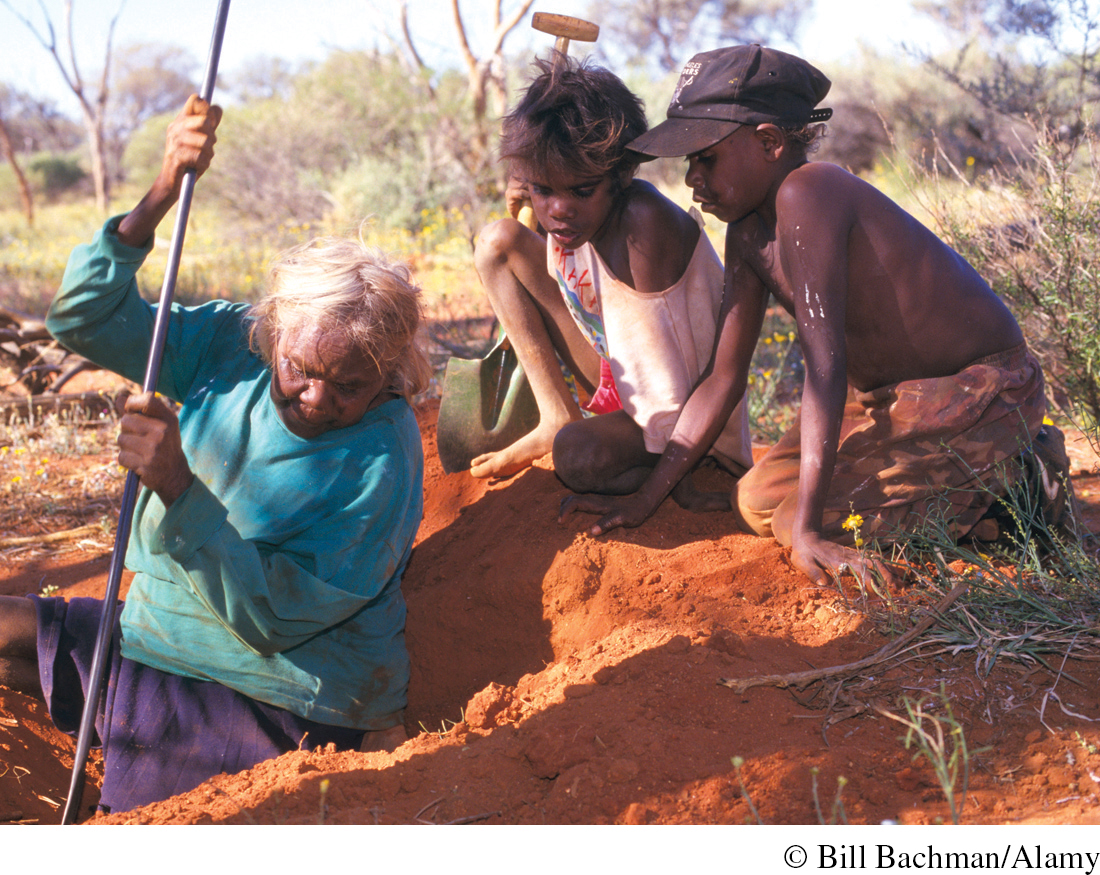The First Human Societies
Above all else, these Paleolithic societies were small, consisting of bands of twenty-five to fifty people, in which all relationships were intensely personal and normally understood in terms of kinship. The available technology permitted only a very low population density and ensured an extremely slow rate of population growth. Some scholars speculate that this growth was dramatically interrupted around 70,000 years ago by an enormous volcanic eruption on the island of Sumatra in present-day Indonesia, resulting in a cooler and drier global climate and causing human numbers to drop to some 10,000 or less. From that point of near extinction, world population grew slowly to 500,000 by 30,000 years ago and then to 6 million by 10,000 years ago.3 Paleolithic bands were seasonally mobile or nomadic, moving frequently and in regular patterns to exploit the resources of wild plants and animals on which they depended. The low productivity of a gathering and hunting economy normally did not allow the production of much surplus, and because people were on the move so often, transporting an accumulation of goods was out of the question.
All of this resulted in highly egalitarian societies, lacking the many inequalities of wealth and power that came later with agricultural and urban life. With no formal chiefs, kings, bureaucrats, soldiers, nobles, or priests, Paleolithic men and women were perhaps freer of human tyranny and oppression than any subsequent kind of human society, even if they were more constrained by the forces of nature. Without specialists, most people possessed the same set of skills, although male and female tasks often differed sharply. The male role as hunter, especially of big game, perhaps gave rise to one of the first criteria of masculine identity: success in killing large animals.
In what ways did a gathering and hunting economy shape other aspects of Paleolithic societies?

Native Australians A small number of Aboriginal Australians maintained their gathering and hunting way of life well into the twentieth century. Here an older woman shows two young boys how to dig for honey ants, a popular food. (© Bill Bachman/Alamy)
Relationships between women and men usually were far more equal than in later societies. As the primary food gatherers, women provided the bulk of the family’s sustenance. One study of the San people, a surviving gathering and hunting society in southern Africa, found that plants, normally gathered by women, provided 70 percent of the diet, while meat, hunted by men, accounted for just 30 percent. This division of labor underpinned what anthropologist Richard Lee called “relative equality between the sexes with no-one having the upper hand.” Among the San, teenagers engaged quite freely in sex play, and the concept of female virginity was apparently unknown, as were rape, wife beating, and the sexual double standard. Although polygamy was permitted, most marriages were in fact monogamous because women strongly resisted sharing a husband with another wife. Frequent divorce among very young couples allowed women to leave unsatisfactory marriages easily. Lee found that longer-term marriages seemed to be generally fulfilling and stable. Both men and women expected a satisfying sexual relationship, and both occasionally took lovers, although discreetly.4
When the British navigator and explorer Captain James Cook first encountered the gathering and hunting peoples of Australia in 1770, he described them, perhaps a little enviously, in this way:
They live in a Tranquillity which is not disturb’d by the Inequality of Conditions: The Earth and sea of their own accord furnishes them with all things necessary for life, they covet not Magnificent houses, Household-stuff…. In short they seem’d to set no value upon any thing we gave them…. They think themselves provided with all the necessarys of Life.5
The Europeans who settled permanently among such people some twenty years later, however, found a society in which physical competition among men was expressed in frequent one-on-one combat and in formalized but bloody battles. It also meant recurrent, public, and quite brutal beatings of wives by their husbands.6 And some Aboriginal myths sought to explain how men achieved power over women. Among the San, frequent arguments about the distribution of meat or the laziness or stinginess of particular people generated conflict, as did rivalries among men over women. Richard Lee identified twenty-two murders that had occurred between 1920 and 1955 and several cases in which the community came together to conduct an execution of particularly disruptive individuals. More generally, recent studies have found that in Paleolithic societies some 15 percent of deaths occurred through violence at the hands of other people, a rate far higher than in later civilizations, where violence was largely monopolized by the state.7 Although sometimes romanticized by outsiders, the relative equality of Paleolithic societies did not always ensure a utopia of social harmony.
Like all other human cultures, Paleolithic societies had rules and structures. A gender-based division of labor usually cast men as hunters and women as gatherers. Values emphasizing reciprocal sharing of goods resulted in clearly defined rules about distributing the meat from an animal kill. Various rules about incest and adultery governed sexual behavior, while understandings about who could hunt or gather in particular territories regulated economic activity. Leaders arose as needed to organize a task such as a hunt, but without conferring permanent power on individuals.
